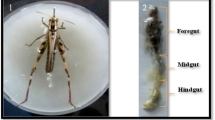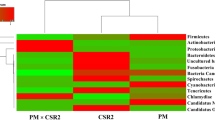Abstract
The eri silkworm, Samia ricini, is associated with symbiotic bacteria believed to be playing several physiological functions to the host. The larvae of S. ricini were subjected to isolation of gut bacteria using culture-dependent 16S rRNA gene amplification and sequencing; and qualitative and quantitative enzymatic assays. The results of qualitative cellulolytic assays indicated that 58% of the screened gut bacterial isolates had cellulolytic activity. The cellulolytic bacterial isolates belonged to Bacillus sp. (88%), Pseudomonas sp. (8%) and Enterococcus sp. (4%). Quantitative assays indicated that the highest β-glucosidase (13.42 U/mg), endoglucanase (3.60 U/mg) and exoglucanase (2.60 U/mg) activity were in isolates ERI011, ERI009 and ERI097, respectively. Our results further indicate that significant activities of endogenous cellulases are present in the gut fluids of S. ricini. However, a comparative analysis of the cellulolytic activity showed that the endoglucanase activity of bacterial origin was 13 and 18-fold higher in the foregut and midgut, respectively, than that in gut fluids. Similarly, the β-glucosidase activity was 20 and ninefold higher compared with gut fluids from the same compartments. The higher cellulolytic activity of bacterial origin compared with that of insect origin suggests that more cellulose digestion may be aided by cellulases of bacterial origin. These cellulolytic gut bacterial isolates may be good sources for profiling novel genes and biomolecules for biotechnological application.



Similar content being viewed by others
References
Chen B, Teh BS, Sun C, Hu S, Lu X, Boland W, Shao Y (2016) Biodiversity and activity of the gut microbiota across the life history of the insect herbivore Spodoptera littoralis. Sci Rep 8:1–4
Delalibera I Jr, Handelsman JO, Raffa KF (2005) Contrasts in cellulolytic activities of gut microorganisms between the wood borer, Saperda vestita (Coleoptera: Cerambycidae), and the bark beetles, Ips pini and Dendroctonus frontalis (Coleoptera: Curculionidae). Environ Entomol 34:541–547
Engel P, Moran NA (2013) The gut microbiota of insects–diversity in structure and function. FEMS Microbiol Rev 37:699–735
Felsenstein J (1985) Confidence limits on phylogenies: an approach using the bootstrap. Evol 39:783–791
Fischer R, Ostafe R, Twyman RM (2013) Cellulases from insects. InYellow Biotechnology II 2013 (pp. 51–64). Springer, Berlin, Heidelberg
Gandotra S, Kumar A, Naga K, Bhuyan PM, Gogoi DK, Sharma K, Subramanian S (2018) Bacterial community structure and diversity in the gut of the muga silkworm, Antheraea assamensis (Lepidoptera: Saturniidae), from India. Insect Mol Biol 27:603–619
Haloi DJ, Borkotoki A, Mahanta R, Haloi IH (2012) Cellulase Activity and Kinetics in Rice Grasshopper Hieroglyphus banian (Orthoptera: acrididae). Indian J Sci Technol 5:3753–3757
Hernández-García JA, Briones-Roblero CI, Rivera-Orduña FN, Zúñiga G (2017) Revealing the gut bacteriome of Dendroctonus bark beetles (Curculionidae: Scolytinae): diversity, core members and co-evolutionary patterns. Sci Rep 7:1–2
Huang S, Sheng P, H. Zhang H, (2012) Isolation and identification of cellulolytic bacteria from the gut of Holotrichia parallela larvae (Coleoptera: Scarabaeidae). Int. J. Mol. Sci. 13:2563–2577
Kimura M (1980) A simple method for estimating evolutionary rates of base substitutions through comparative studies of nucleotide sequences. J Mol Evol 16:111–120
Kumar D, Parshad R, Gupta VK (2014) Application of a statistically enhanced, novel, organic solvent stable lipase from Bacillus safensis DVL-43. Int J Biol Macromol 66:97–107
Lisdiyanti P, Suyanto E, Rahayu GNF, W, (2012) Isolation and characterization of cellulase produced by cellulolytic bacteria from peat soil of Ogan Komering Ilir, South Sumatera. Int J Environ Bioen 3:145–153
Mathews SL, Epps MJ, Blackburn RK, Goshe MB, Grunden AM, Dunn RR (2019) Public questions spur the discovery of new bacterial species associated with lignin bioconversion of industrial waste. R Soc Open Sci 6:180748
Mereghetti V, Chouaia B, Montagna M (2017) New insights into the microbiota of moth pests. Int J Mol Sci 18:2450
Meth T, Gogoi H (2016) Original Research Article Rearing of Eri Silkmoth (Samia cynthia ricini Boisd.)(Lepidoptera: Saturniidae) In Arunachal Pradesh: A Study In Papumpare District. J Bioresources 3:46–52
Mika N, Zorn H, Rühl M (2013) Insect-derived enzymes: a treasure for industrial biotechnology and food biotechnology. In Yellow Biotechnology II (pp. 1–17). Springer, Berlin, Heidelberg
Nardi JB, Mackie RI, Dawson JO (2002) Could microbial symbionts of arthropod guts contribute significantly to nitrogen fixation in terrestrial ecosystems? J Insect Physiol 48:751–763
Pothula R, Shirley D, Perera OP, Klingeman WE, Oppert C, Abdelgaffar HMY et al (2019) The digestive system in Zygentoma as an insect model for high cellulase activity. PLoS ONE 14:e0212505
Shelomi M, Watanabe H, Arakawa G (2014) Endogenous cellulase enzymes in the stick insect (Phasmatodea) gut. J Insect Physiol 60:25–30
Shi W, Xie S, Chen X, Sun S, Zhou X, Liu L, Gao P, Kyrpides NC, No EG, Yuan JS (2013) Comparative genomic analysis of the endosymbionts of herbivorous insects reveals eco-environmental adaptations: biotechnology applications. PLoS Genet 9
Shil RK, Mojumder S, Sadida FF, Uddin M, Sikdar D (2014) Isolation and identification of cellulolytic bacteria from the gut of three phytophagus insect species. Brazilian Arch Biol Technol 57:927–932
Subramanianan K, Sakthivel N, Qadri SMH (2013) Rearing technology of eri silkmoth (Samia cynthia ricini) under varied seasonal and host plant conditions in Tamil Nadu. Int J Life Sci Biotechnol Pharma Res 2:130–141
Swathiga G, Umapathy G, Parthiban KT, Angappan K (2019) Growth response of different eco races of ERI silkworm reared on various castor genotypes. J Entomol Zool Stud 7:1406–1410
Taggar MS (2015) Insect cellulolytic enzymes: novel sources for degradation of lignocellulosic biomass. J Appl Nat Sci 7:625–630
Watanabe H, Tokuda G (2010) Cellulolytic systems in insects. Annu Rev Entomol 55:609–632
Willis JD, Oppert C, Jurat Fuentes JL (2010) Methods for discovery and characterization of cellulolytic enzymes from insects. Insect Sci 17:184–198
Zhang M, Su R, Qi W, He Z (2010) Enhanced enzymatic hydrolysis of lignocellulose by optimizing enzyme complexes. Appl Biochem Biotechnol 160:1407–1414
Zhang ZY, Yuan Y, Ali MW, Peng T, Peng W, Raza MF, Zhao Y, Zhang H (2018) Cultivable anaerobic and aerobic bacterial communities in the fermentation chambers of Holotrichia parallela (Coleoptera: Scarabaeidae) larvae. PLoS ONE 13:e0190663
Zhang YP, Hong J, Ye X (2009) Cellulase assays. In Biofuels (pp. 213–231). Humana Press, Totowa, NJ
Acknowledgment
The authors gratefully acknowledge the help and support given by the Indian Council for Agricultural Research-Indian Agricultural Research Institute, New Delhi and National Agricultural Higher Education Project-Center for Advancement in Agriculture, Science and Technology programme of Indian Council of Agricultural Research, New Delhi and Indian Council for Cultural Relations, Government of India for their support for this research programme. Special thanks should go to members of the Insect Molecular Genetics and Microbial Genetics laboratories of the Division of Entomology and Division of Microbiology, ICAR-IARI, for their assistance.
Author information
Authors and Affiliations
Contributions
Kondwani MsangoSoko conducted the experiments, analyzed the data and wrote the manuscript; Ramcharan Bhattacharya, Barasubramanian Ramakrishnan and Kirti Sharma imputed into the project idea and its execution; Sabtharishi Subramanian conceived the project and helped with writing and proofreading the manuscript. All authors reviewed the manuscript.
Corresponding author
Ethics declarations
Competing interests
The authors declare no conflict of interest, involvement, financial or otherwise, that may potentially bias our work.
Rights and permissions
About this article
Cite this article
MsangoSoko, K., Bhattacharya, R., Ramakrishnan, B. et al. Cellulolytic activity of gut bacteria isolated from the eri silkworm larvae, Samia ricini, (Lepidoptera: Saturniidae). Int J Trop Insect Sci 41, 2785–2794 (2021). https://doi.org/10.1007/s42690-021-00459-x
Received:
Accepted:
Published:
Issue Date:
DOI: https://doi.org/10.1007/s42690-021-00459-x




